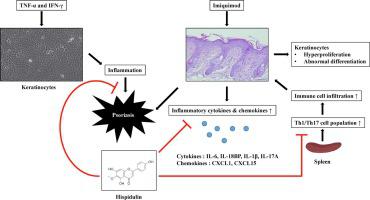International Immunopharmacology ( IF 5.6 ) Pub Date : 2020-07-14 , DOI: 10.1016/j.intimp.2020.106767 Namkyung Kim 1 , Soyoung Lee 2 , Jinjoo Kang 1 , Young-Ae Choi 1 , Byungheon Lee 3 , Taeg Kyu Kwon 4 , Yong Hyun Jang 5 , Sang-Hyun Kim 1

|
Psoriasis is a chronic inflammatory skin disease characterized by hyperproliferation and abnormal differentiation of epidermal keratinocytes accompanied by increased infiltration of immune cells. Previous studies have demonstrated that hispidulin (4′,5,7-trihydroxy-6-methoxyflavone, HPD) has various pharmacological benefits such as anti-fungal, anti-inflammation, and anti-allergic effects. This study investigated the effectiveness of HPD to treat psoriasis using an imiquimod (IMQ)-induced mouse model and activated keratinocytes. IMQ was topically applied to the back skin of mice for six consecutive days, and the mice were orally administered HPD. Based on the histological observation and immunological analysis, oral administration of HPD suppressed psoriatic characteristics including skin thickness, psoriasis area severity index, transepidermal water loss, and neutrophil infiltration. HPD alleviated pathologically increased levels of immunoglobulin G2a, myeloperoxidase, and tumor necrosis factor-α. Splenic Th1 and Th17 cell populations were also reduced by HPD in the murine model. In addition, in activated keratinocytes, HPD inhibited gene expression of Th1- and Th17-associated cytokines and chemokines, and phosphorylation of mitogen-activated protein kinases and nuclear factor-κB. In summary, HPD alleviates psoriasis skin inflammation in vivo and in vitro. Therefore, we suggest that HPD would be a potent therapeutic candidate for the treatment of psoriasis.
中文翻译:

Hispidulin通过抑制脾Th1 / Th17细胞群体和角质形成细胞的活化,减轻了咪喹莫特诱发的牛皮癣样皮肤炎症。
牛皮癣是一种慢性炎症性皮肤病,其特征在于表皮角质形成细胞过度增殖和异常分化,并伴有免疫细胞浸润的增加。先前的研究表明,组蛋白(4',5,7-三羟基-6-甲氧基黄酮,HPD)具有多种药理作用,例如抗真菌,抗发炎和抗过敏作用。这项研究调查了HPD使用咪喹莫特(IMQ)诱导的小鼠模型和活化的角质形成细胞治疗牛皮癣的有效性。将IMQ连续六天局部施用于小鼠的背部皮肤,并给小鼠口服HPD。根据组织学观察和免疫学分析,HPD口服抑制了牛皮癣特征,包括皮肤厚度,牛皮癣面积严重性指数,表皮失水和中性粒细胞浸润。HPD在病理上减轻了免疫球蛋白G2a,髓过氧化物酶和肿瘤坏死因子-α的水平。在鼠模型中,HPD还降低了脾脏Th1和Th17细胞的数量。此外,在活化的角质形成细胞中,HPD抑制Th1和Th17相关细胞因子和趋化因子的基因表达,并抑制丝裂原活化的蛋白激酶和核因子κB的磷酸化。总之,HPD缓解牛皮癣皮肤炎症 HPD抑制Th1和Th17相关细胞因子和趋化因子的基因表达,以及丝裂原激活的蛋白激酶和核因子κB的磷酸化。总之,HPD减轻了牛皮癣皮肤的炎症 HPD抑制Th1和Th17相关细胞因子和趋化因子的基因表达,以及丝裂原激活的蛋白激酶和核因子κB的磷酸化。总之,HPD减轻了牛皮癣皮肤的炎症体内和体外。因此,我们建议HPD将是治疗牛皮癣的有效候选药物。


























 京公网安备 11010802027423号
京公网安备 11010802027423号